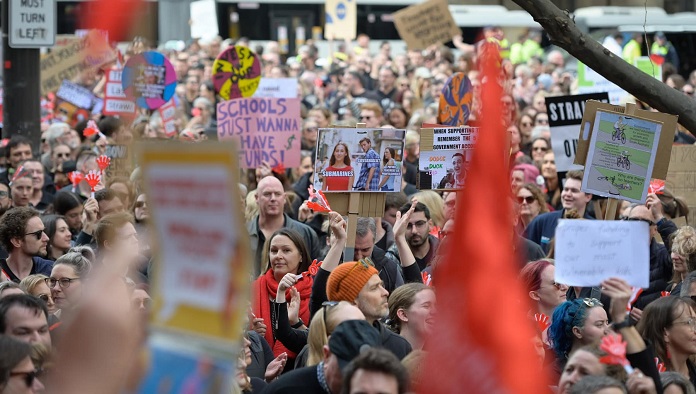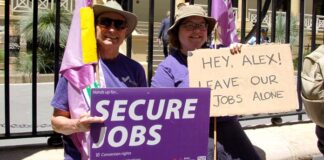Welcome to Solidarity’s monthly round-up of working class struggle.
SOUTH AUSTRALIA: Thousands of teachers, members of the Australian Education Union, went on a 24-hour strike on 1 September over what they dubbed “an insulting” pay offer from Labor.
Many hundreds of teachers attended a rally at State Parliament to tell Premier Peter Malinauskas and Education Minister Blair Boyer that their below-inflation offer of a 3 per cent annual pay rise over the next three years didn’t make the grade.
The AEU wants an above-inflation pay rise of 8.6 per cent for the first year and 5.5 per cent in the following two years.
The action shut 167 schools, with another 152 operating on a “modified” timetable, after a strike ballot won with an historic 80 per cent of teachers in favour.
The AEU has been negotiating with the SA Government for eight months.
Teachers on strike create political headaches for governments as employers bemoan the loss of profits, with many workers with children taking the day off or bringing their children to work.
After the rally, AEU state branch president Andrew Gohl posted on social media that the union was proposing another strike soon.
ADELAIDE: Tram drivers, members of the Rail Tram and Bus Union held their second four-hour strike on the same day as the teachers’ strike over their pay claim with Torrens Connect.
The strikers want 21 per cent over three years. They are also striking to remove split shifts to reduce fatigue and to receive improved training.
QUEENSLAND: More than 4000 teachers and support staff at Catholic private schools, members of the Independent Education Union, held a one-hour strike on 23 August over pay and workload stress.
Members took action in 106 out of 331 schools because the Catholic Education Commission won’t negotiate a decent pay rise and fund measures to alleviate teacher stress.
NATIONAL: Workers at call centres for Services Australia (Centrelink), members of the Community and Public Sector Union, began two weeks of bans from 1 August.
They are the first federal public service agency to take action, after a huge 86 per cent of the CPSU’s 15,000 members voted in favour of a protected action ballot.
The CPSU wants a 20 per cent pay rise over three years, after nine years of pay being held down by Liberal governments and in response to Labor’s 10.5 per cent offer over three years.
In an adversarial start to negotiations, Katy Gallagher, Finance Minister and a former CPSU organiser, said the CPSU pay demand was “impossible”.
In late August, after the bans, the government increased its pay offer by 0.7 per cent to 11.2 per cent.
BRISBANE: More than 500 bus drivers from three bus companies, members of the Transport Workers Union, went on strike on 16 August for pay rises of up to 8 per cent.
Clarks Logan City Bus Service, Sunshine Coast’s Sunbus and Gold Coast’s Kinetic services were disrupted.
Striking Clarks drivers rallied at Logan’s Gould Adams Park in the first strike at the company since its foundation in 1976.
The TWU claims put to the three companies differ in each area. Gold Coast drivers are calling for a 3.5 per cent increase, on top of what the company is offering.
In Brisbane, where it was a long weekend for the Ekka, an annual agricultural show, some TransLink bus services were also affected.
CANBERRA: Electricians, members of the Electrical Trades Union, at the Territory’s part state-owned, part-private poles and wires operator, Evoenergy, have been holding rolling one-hour stoppages since 25 July for a pay rise.
Between 150 and 200 sparkies want more than Evoenergy’s pitiful offer of 8 per cent over three years.
The offer fuelled a 90 per cent vote in favour of unlimited eight-hour strike action.
So far strikers have rallied at Evoenergy’s Greenway depot to show their anger with the company.
Electricity workers literally have the power to close down workplaces. In addition, federal government computers/data centres need an ambient temperature of 21.5-23.5 degrees of aircon to remain efficient.
MELBOURNE: 14 electricians, members of the ETU, have been on strike for a month in Thomastown at Enersys, a battery and energy tech maker for companies like Telstra. They are after an inflation-level pay rise and improved working conditions.
While Enersys revenue in Australia is up 10 per cent in 2023 and its 32 plants around the world had revenue of $3.4 billion, the company is trying to force through a pay cut in real terms.
Workers’ last pay rise was only 2 per cent in April 2022 and their EBA expired in March.
Provocatively, the company HR manager Lynda Ratkovic told strikers, “Let’s see who starves first.”
Supporters are encouraged to visit the picket line on weekdays between 7am and 3pm, at the corner of Dalton and Settlement roads.
MELBOURNE: At Kilsyth, metalworkers at B+D roller doors took their eighth day of strike action in August for a better pay rise.
The parent company of B+D also sells Black and Decker, DeWalt and Stanley tools. It is offering 3 per cent per year for three years. The Australian Manufacturing Workers Union has described the pay offer as “measly”.
SYDNEY: After two days on “indefinite strike” from 21 August, workers at Prysmian, a cable manufacturer in Liverpool, won a decent pay rise and an EBA which remains in place if the business relocates.
The AMWU, ETU and UWU members united for the win.
Prysmian had refused to guarantee future job security at its plant although internationally it has record revenue, up 14 per cent to $2.5 billion.
Prysmian supplies most of the state’s power grid and major construction sites, like the NSW state government flagship, the WestConnex freeway tunnel. That last contract alone is worth $11 million.
So the company was under pressure to settle, and buckle it did.
WESTERN AUSTRALIA: Strikes at three Chevron platforms in the northern gas fields were looming as this article was published. Up to 450 workers from the Offshore Alliance were ready to take action after Woodside settled with the unions over a pay rise.
The Alliance is made up of the Maritime Union of Australia and the Australian Workers Union. The former is a historically left-wing union and the latter a historically right-wing union, yet they have found common cause.
Three of the four major gas companies have agreements with the OA, with Chevron the odd one out.
Workers at Chevron’s Gorgon, Wheatstone Downstream and Wheatstone platforms voted for protected industrial action.
Chevron tried to circumvent this with a non-union staff ballot, which was almost unanimously rejected.
Historically, disputes at resource projects in northern WA and remote coal mines in Queensland have not affected the working class movement due to their physical isolation, the small numbers involved and the highly-paid nature of the work.
But bosses and governments pay more attention to strikes in these two fossil fuel industries as they affect lucrative exports.
Chevron supplies 7 per cent of the world’s gas and world financial markets have been jittery at the prospect of a strike in WA. Chevron supplies 47 per cent of WA’s domestic market.
The company has applied for “assistance” from the generally anti-union Fair Work Commission in “getting negotiations going” after its humiliation in the staff ballot.
The Alliance said on social media that Chevron’s bargaining process was a “train wreck”.
By Tom Orsag






